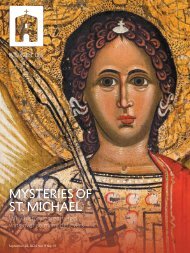Angelus News | April 21, 2023 | Vol. 8 No
On the cover: Christ pulls Adam out of “limbo” while surrounded by other biblical figures in a late 13th-century painting (artist unknown). St. John Chrysostom famously wrote about Easter: “Forgiveness is risen from the grave.” But what does that mean for us? On Page 10, Mike Aquilina details how history, Scripture, and the experience of the apostles reveals forgiveness as the Resurrection’s most tangible result. On Page 14, Jennifer Hubbard recounts how her 6-year-old daughter’s murder in the Sandy Hook shooting led her on a journey to do the impossible.
On the cover: Christ pulls Adam out of “limbo” while surrounded by other biblical figures in a late 13th-century painting (artist unknown). St. John Chrysostom famously wrote about Easter: “Forgiveness is risen from the grave.” But what does that mean for us? On Page 10, Mike Aquilina details how history, Scripture, and the experience of the apostles reveals forgiveness as the Resurrection’s most tangible result. On Page 14, Jennifer Hubbard recounts how her 6-year-old daughter’s murder in the Sandy Hook shooting led her on a journey to do the impossible.
You also want an ePaper? Increase the reach of your titles
YUMPU automatically turns print PDFs into web optimized ePapers that Google loves.
into death.<br />
In Chapter 2, he speaks of himself<br />
as the bridegroom who will be taken<br />
away, a veiled allusion to his violent<br />
death (Mark 2:20). In Chapter 3, his<br />
enemies are plotting “against him to<br />
put him to death” (Mark 3:6). As the<br />
story advances, allusions to his suffering<br />
become more frequent and more<br />
direct. Halfway through the Gospel,<br />
Jesus openly predicts his passion and<br />
resurrection as he heads to Jerusalem<br />
with his disciples.<br />
Throughout, Jesus makes a point of<br />
calling the disciples and pulling them<br />
into his own life. <strong>No</strong>t because he<br />
wants them to suffer, but because he’s<br />
preparing them for the most important<br />
experience of their lives.<br />
Each time he speaks of his passion,<br />
the disciples resist it, whether it’s<br />
Peter rebuking Jesus (Mark 8:32),<br />
the disciples quarreling about who<br />
is the greatest (Mark 9:34, or James<br />
and John seeking the places of honor<br />
(Mark 10:37).<br />
Undeterred, Jesus patiently explains<br />
what kind of life he’s drawing them to:<br />
one of denying themselves and following<br />
him, giving priority to the small<br />
and vulnerable among us (Mark 9:36),<br />
taking the last place (Mark 9:35;<br />
10:43), and receiving the kingdom<br />
like a child (Mark 10:15). Becoming<br />
servants, small and vulnerable, taking<br />
the last place, Jesus invites them into<br />
his own lifestyle, which he will exemplify<br />
most fully on the cross.<br />
Mary is no stranger to this path of<br />
smallness, vulnerability, service, and<br />
self-denial. In the annunciation scene,<br />
she responds to God by saying “be<br />
it done unto me according to your<br />
word.” She understands that accepting<br />
God’s plan means renouncing whatever<br />
other plans she might have had.<br />
For Mary, this means even giving<br />
up the human ties with her only<br />
son. When Jesus seemingly distances<br />
himself from her during his public<br />
ministry — “Who are my mother and<br />
[my] brothers?” (Mark 3:33) — she<br />
learns to die to the human bonds that<br />
bind her to Jesus and to give rise to<br />
a new way of relating to him. “My<br />
mother and my brothers,” Jesus says,<br />
“are those who hear the word of God<br />
and act on it” (Luke 8:<strong>21</strong>).<br />
When her 12-year-old Son, for whom<br />
she and Joseph had anxiously looked<br />
for three days, stated that he had to<br />
be in his Father’s house, Mary and Joseph<br />
did not understand what he said<br />
to them (Luke 2:50). She struggles<br />
with understanding God’s designs and<br />
learns to accept what surpasses understanding,<br />
a lesson she will undertake<br />
again at the cross.<br />
In a small but telling detail, St. Luke<br />
tells us that she mentions Joseph first:<br />
“Your father and I have been looking<br />
for you” (Luke 2:48). Mentioning<br />
Joseph first, she takes the last place.<br />
Because she is so perfectly set on the<br />
path of smallness, self-denial, service,<br />
and childlike trust, Jesus wants us<br />
to hold on to her — “Behold, your<br />
mother” — as we enter our dying and<br />
rising with Christ. She will intercede<br />
for us when our wine runs short. And<br />
she will encourage us — “Do whatever<br />
he tells you” (John 2:5) — to help<br />
bring about the new wine so that “we<br />
too might live in newness of life.”<br />
(Romans 6:4)<br />
Because she is so perfectly set on the path of<br />
smallness, self-denial, service, and childlike trust,<br />
Jesus wants us to hold on to his mother as we<br />
enter our dying and rising with Christ.<br />
This is good news. This Easter, if<br />
we’re struggling to be small, take the<br />
last place, or trust in God; her Son<br />
wants us to enter the Paschal Mystery<br />
with his mother, holding on to her as<br />
we live out our dying and rising with<br />
Christ.<br />
Father Slawomir Szkredka is the<br />
coordinator of human formation at St.<br />
John’s Seminary in Camarillo and the<br />
author of the new book “Icon of Trust:<br />
Mary in the Gospels of Luke and John”<br />
(Sophia Institute Press, $13.95).<br />
<strong>April</strong> <strong>21</strong>, <strong>2023</strong> • ANGELUS • 25


















